Michael Phelps & Bob Bowman Hail Kristof Milak As Coach Selmeci Says “Everything Changes”
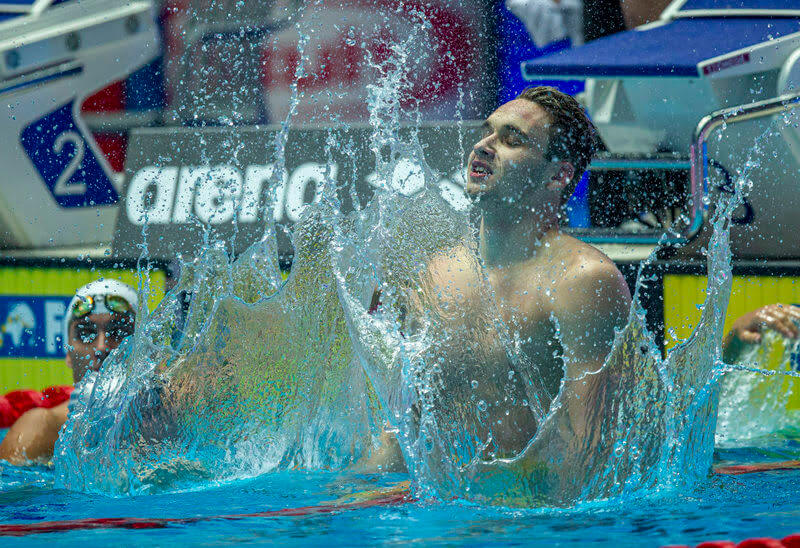
Editorial content for the 2019 World Championships coverage is sponsored by FORM Swim Goggles.
See full event coverage.
Follow FORM on Instagram at @FORMSwim #swimwithform

World Swimming Championships (Michael Phelps, Bob Bowman, Kristof Malik)
Gwangju, Day 4 finals
Plaudits from Michael Phelps, praise from Bob Bowman, hats and ‘everything else’ off from Chad Le Clos.
Then there’s coach Atilla Selmeci, who wants to keep Kristof Malik‘s feet on the ground and broad shoulders to the wheel after watching his charge fly to a 1:50.73 world record inside Phelps’ pioneering pace over 200m butterfly at Rome 2009 in shiny suit.
Assuming the trajectory that has been travelled of late by teenagers Kristof Milak and Gianluca Urlando continues apace over the coming year, the Tokyo 2020 Olympic Games could witness an almighty 200m butterfly battle in a race below 1min 50.
Here in Gwangju, Milak is a world champion and will forever be known as the man who ended Phelps’ 18-year reign at the helm of global 200m butterfly pace.
Urlando, of the United States, is neither here nor inside the pace of his fellow and the famous American but on a 1:53 several weeks back in the calm of local waters, the 17-year-old talent laid down a marker for his ambitions and potential at Olympic trials next year.
There is a sense of a changing of the guard in Gwangju, Ariarne Titmus, Maggie MacNeil and now Milak among those reminding established stars, punters, tipsters and all who care to see that time waits for no man nor woman on the conveyor of sporting progress.
Selmeci has been Milak’s coach for the past few years since he sat a young teenager down to have a chat about what it would take if he wanted to unlock the best butterflyer in him.
Today, a few years on, past milestones such as a 1:53 for the World Junior gold at 16 and a 1:52 that made him the fastest teenager in history in 2017, Milak hunted down a crown only to land an aquatic Kingdom.
The splits and the quotes that follows speak volumes:
- 24.66 52.88 (28.22) 1:21.57 (28.69) 1:50.73 (29.16) Milak 2019 WR
- 24.76 52.88 (28.12) 1:21.93 (29.05) 1:51.51 (29.58) Phelps 2009 WR (in shiny by the GOAT, whose coach, Bob Bowman, brought on the deadline for the suits to be sunk on January 1, 2010)
In textile, Phelps’ tour de force was a 1:52.09 from a soaring, searing swim at Melbourne 2007 when the Fifth Stroke – dolphin driving off blocks and walls – changed the game.
Asked if records came as a surprise, Milak said: “I didn’t really expect to break the record but I was prepared for it. It’s now going to be much harder to set a new personal best.”
What did Selmeci think of the history that had just unfolded? He was in two minds.
“Of course, this is something to celebrate,” said Selmeci.
“But it changes everything. At home, now, he will be in the spotlight. People will want to know more about him and make demands on his time.”
Time that needs to be spent on getting the job done if they are to convert this golden day into another a year from now in Tokyo.
Milak, from a “family of modest means” is said by Hungarian journalists to be a “boy who thrives on being a favourite”. His mother, a teacher, drove him 100-mile round trips to and from training throughout much of her son’s youth.
“At 19, he needs a lot of convincing, persuading,” Selmeci told Swimming World through an interpreter. He’d sat a young teenager down a few years ago and told him what might be if he put the work in:
“I told him ‘believe me, its’s a lot of hard work but you have to do it. You will have the rewards if you do the work – but there’s no way round the work’.”
“Now, well, he’s in the spotlight and I must go home, get out the good old notes I inherited from Széchy and understand what we must do next, how to reshape the preparations. Every season is different anyway so we wouldn’t just copy what we’ve done before. We have to build on it anyway.”
Milak was a talent and promise before today, said Selmeci, “but from today, it will be very different. We need to adjust to the new circumstance and take care with that.”
It has not always been plain sailing with Milak, he suggests. “He has always been a young man who asks questions, he wants to know what and why. He has his ups and downs and I want to push him to his limits and he doesn’t always want to go there.”
He went there and beyond today but Selmeci did not get excited until the clock confirmed what he thought beyond reach even as Milak sped home down the last lap. Surrounded by Hungarian coaches screaming ‘it’s a world record’, Selmeci kept saying ‘no, no…’. Rome was a time of no fatigue, no fall off at the end of races.
Even so, a yes followed.
Blistering Back End
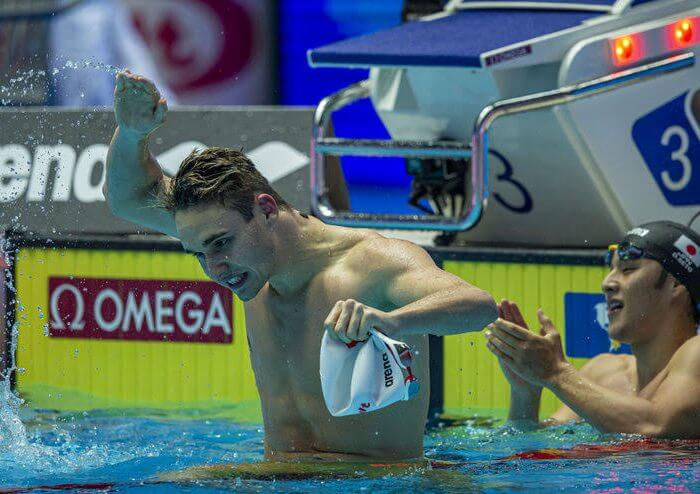
Kristof Milak – Photo Courtesy: Patrick B. Kraemer
“Without a doubt the most impressive part of his race is the last 100,” Bob Bowman told Swimming World after watching Milak take down a Phelps signature standard that many thought would stand the test of time for a while longer. Added Bowman:
“57.8 takes things to a new level. I very much like his stroke, very similar to MPs in many ways. He stays long and low, breathes forward at the surface and has a strong and constant kick. The way he has been swimming over the past year, I thought he could take a shot at the record but I was not expecting him to break 1:51 at this meet. What an amazing swim!! Hats off to Kristof!”
Chad Le Clos, one of few men to have known what it was like to get a fingertip to the wall ahead of Phelps and third home in the race today, thought the swim worth taking more than your hat off for:
“I’m pretty shocked with what a great time it was, it was unbelievable. Looking at the splits are just phenomenal. Nothing changes for me. Just a new guy that I have to hunt next year so nothing changes. Congratulations: I have to take my hat off, I have to take everything off, to say what a phenomenal record it was. He actually shattered it! 1:50.7 is a freestyle time: I think I went 1:49 at nationals 200 free so that’s a very special time.”
Milak’s teammate and a swim legend in his own right, Laszlo Cseh, whose shared silver with Phelps and Le Clos in a 100m butterfly outcome at the Rio 2016 Games that bound together forever three towering rivals, said: “It is an amazing time. It’s absolutely fantastic so after that swim I don’t think anybody can go close to him so it was amazing.”
Asked if he had mixed feelings about the records, World and Cseh’s Hungarian standard from 2008 downed in one go, Cseh said:
“I don’t know – that is the thing how the world works. It’s always getting faster swimmer or better athletes so I think it is normal. Before Rio I also thought to myself ‘I can beat that record’ but I think every record can be broken, no-one is safe so everything is possible.”
And … last of the plaudits of greats from the GOAT:
Milak was travelling at the speed of Bruce Furniss on freestyle 1975-76 en route to Olympic gold in Montreal. What did Michael Phelps himself think? He told Karen Crouse at The New York Times:
“As frustrated as I am to see that record go down, I couldn’t be happier to see how he did it. That kid’s last 100 was incredible. He put together a great 200 fly from start to finish. It happened because there was a kid who wanted to do it, who dreamed of doing it, who figured out what it would take to do it, who worked on his technique until it was beautiful and who put in the really, really hard work that it takes to do it. My hat’s off to him.”
Hard work that it takes. Spot on.
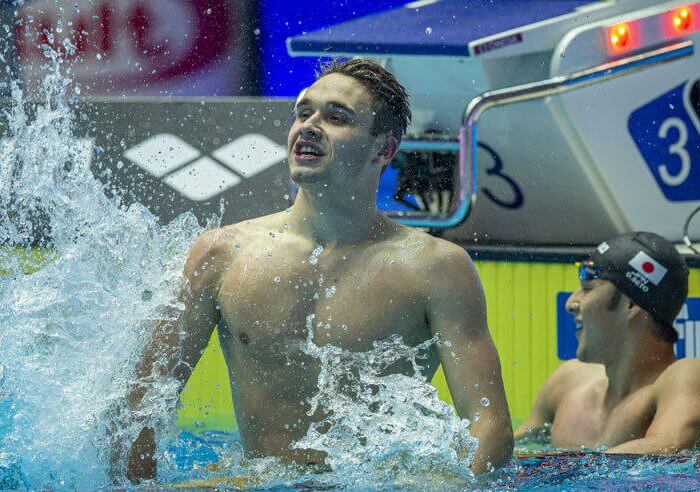
Kristof Milak – Photo Courtesy: Patrick B. Kraemer
The Old School
Milak’s coach Attila Selmeci put his charge’s pioneering speed down to old-fashioned hard work “from the coaching school of Tamás Széchy and Laszlo Kiss”.
Hall of Famer Széchy coached Hungarian swimmers to 15 Olympic podiums, including 8 golds, and 21 World-Championship honours. Those date from the generation of Andras Hargatay in the early late 1960s and early 1970s through the likes of Sandor Wladar, Zoltan Verraszto, Jozsef Szabo and, more recently medley great Tamas Darnyi, Norbert Rozsa and Attila Czene.
Széchy died in 2004, while Kiss, long-time Hungarian head coach, his successes including the legendary Krisztina Egerszegi, was haunted of late by news of a criminal past in his youth.
In Hungarian swimming, those coaches were known as hard task masters who helped to build Hungary’s reputation for aquatic mastery.
Milak trained and raced for Erd, a town and club on the outskirts of Budapest, until swimmer and coach outgrew the set-up there. They moved to Hungary’s biggest club for the support and back-up they could get but most days Milak has a lane to himself at the Duna Arena, venue of the 2017 World Championships.
Selmeci, who likes the work environment at the national training centre, said: “He works mostly alone, so we’re grateful for the company of the swimmers, mostly juniors, who come in on a session-by-session basis and gets to train with others.”
Boglarka Kapas and Akos Kalmar, both in Gwangju for Hungary, are among those who train there from time to time, while Katinka Hosszu is based there.
Impressions of Phelps
Milak was just over a year old when Phelps wrote his name in the world-record books for the first time, over 200m butterfly in 2001. Eight times he would take down the mark over the coming eight years – and then hold for another decade.
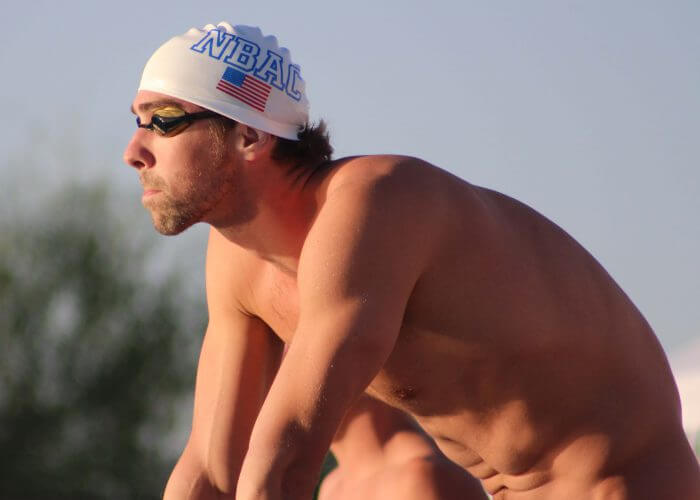
Michael Phelps – Photo Courtesy: Azaria Basile
I ask Milak where he might have been in 2009 when the events of Rome 2009 were unfolding? (Remember the 100m? Are you not entertained? Get me Russell Crowe on the line. Bring on the gladiators. Lions at the ready. Rome awaited a swimming hero – and it got two. It was Mikey Maximus but hardly Milo Minimus. Michael Phelps, 14 Olympic gold medals in tow, rocked the history of his sport in a raw display of pugilistic passion to crack the 50sec barrier over 100m butterfly and drag his Serbian rival, Milorad Cavic, into uncharted waters with him. It has been 33 years and 7 days since Jim Montgomery of the US sent a Montreal Olympics crowd into a frenzy with the first sub-50sec 100m freestyle swim. He wore nylon briefs at a Games that introduced goggles and underwater vision to Olympic waters …. In what will go down as the ultimate battle of the bodysuits before the shiny stuff sinks on January 1 next year, Phelps and Cavic surfed on a tide of strategy and raw score-to-settle aggression).
Milak thinks back, laughs and says: “I was 9 … somewhere at a youth championship, that’s where I would have been at 9.”
He had not watched Phelps flying to his 1:51.5. “I was not so heavily into swimming then and not so enthusiastic back then,” he said through Csurka. “My first real impressions of Phelps were from London 2012 – and then again in Rio 2016.”
Milak hails from a family of modest means, say Hungarian reporters. “Swimming is everything,” said one.
His mother, a teacher, would drive the young Kristof “100 miles back and forth to training, and that was not easy, for many years when he was very young”.
Phelps’ stranglehold on top speed over four laps ‘fly lasted 18 years, 3 months and 24 days and came to an end at the hand of a teenager who had threatened as much since he was 16 and was watching grainy videos of the GOAT’s best swims to study pace and the poise of a human porpoise.
Imagine that: 0.78sec swifter over the last two laps of the race than Phelps was in a shiny suit back in Rome. At the 100m, level with the pace off Phelps, Milak had caught a fleeting glimpse of Le Clos, a man whose victory helped spark a comeback to end them all London 2012 to Rio 2016. The South African will long serve as a reminder that young lions can take out the Pride Male (and that Pride Males can lick their wounds and live to fight another day, too).
Off the wall and into the third lap today, Milak turned his face to the future: “Once I did my dolphin kicks, I started to focus solely on myself. I didn’t think of anything else, just my rhythm that I practice in training,” said Milak, through the interpreting skills of journalist Gergely Csurka.
Reaction to Milak’s efforts included incredulity but the potential for a 1:50 was written on the wall some time back.
- 2016: At the 2016 European Championships, aged 15, Milak took the 200m ‘fly title for the first time in 1:56.77 after 1:58.17 in heats and 1:58.68 in semis. Those swims marked his first serious foray below 2 minutes.
- 2017: in November, Milak set the world junior record of 1:53.79 for the European Junior crown in Netanya, Israel. Then 17, he axed 1.58secs off the previous junior global mark of 1:55.37 set by Japan’s Nao Horomura in April that year – and 2.03 off the championship record. All of which left Milak second in the world that year.
- 2018: in March 2018 at Hungarian nationals, Milak rattled Cseh‘s 10-year-old 1:52.70 Magyar mark with a 1:52.71 victory in the 200 ‘fly. The time made Milak the third fastest in history after the 1:51.51 world record of Phelps from 2009 world titles and the Rome shiny suits circus and Cseh’s 1:52.70 behind Phelps for Olympic silver in 2008. In textile, only Phelps 2007 world mark of 1:52.09 was faster. Milák had just turned 18 and, at 1:52.71, he was the fastest teenager in history. At the same age, Phelps’ best, for the 2003 world title, was 1:53.93. I
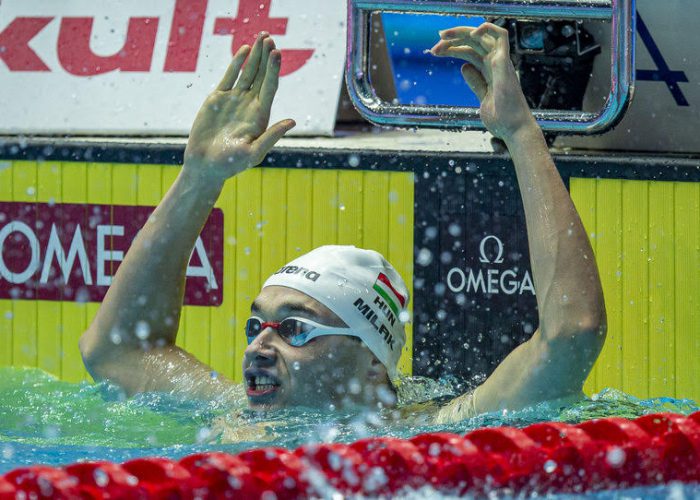
Kristof Milak – Photo Courtesy: Patrick B. Kraemer
In an indication of the work being done on pace and back-end speed, Milak said at the time of the 1:52.71: “I never expected this… even if I am a bit tapered for this event … but of course not fully. I felt that the first hundred was easy but was also ready for the pain in the second half. However, it didn’t hurt that badly. I switched on the extra gears only for the last 25. In summer I’ll do that for the last 50. I still have absolutely no clue how this swim came together… I’m pretty happy with it though somewhat pissed off because of the missing 0.01.”
Selmeci, who guided Beatrix Boulseviczto European short-course medals (gold in 200m ‘fly in 2005 and silver in 2006), worked on Milak’s obvious backstroke talent early in his career. Alex Popov was considered a backstroke swimmer until his late teens, while the stroke provides core strength and stability helpful to butterfly too.
It was under Selmeci’s tutelage that Milak became a frequent flyer capable of taking off in international waters. Like Phelps, though not at the same pace, Milak has shown he can turn his hand to almost any event.
At nationals in Százhalombatta in 2017, he had a crack at all strokes barring breaststroke and turned out the following efforts:
- 400m free: 3:43.50 adrift Péter Bernek’s 3:38.58
- 100m ‘fly: 51.64 ahead of Olympic medallist Laszlo Cseh’s 51.69
- 200m ‘fly: 1:52.02 ahead of Olympic medallist Tamás Kenderesi’s 1:52.60
- 50m back: 23.85 for the win
- 100m back: 52.09 for the win
There were a couple of 49s on 100m free, a 1:45.95 in the 200m free and 23.88 in the 50m butterfly in the bargain.
Selmeci sought not to push Milak into senior waters too soon ands when the swimmer was 17 the coach kept him away from the European s/c titles in Copenhagen “to put a very busy summer and its media spotlight to rest and avoid the risks of fatigue and burnout.”
Selmeci spotted the risk and turned his swimmer over to focus on backstroke once more while taking a rest from all those thumping ‘fly sessions. It worked out well.
Milak has been viewed in Hungary as the next Cseh these past few years of growth. What a compliment: Cseh has 75 international medals in his treasury for Hungary, including six Olympic solo podiums, two world titles and 11 other global long-course honours and 14 European long-course crowns. The count includes achievements on backstroke but mostly butterfly and medley.
There’s a journey ahead on that score but Milak is in the hands of a coach keen to promote longevity in the athlete. Two years ago, he put Milak in touch with Daniel Gyurta to have him talk to the junior about the struggle from junior to senior waters and about perseverance.
Gyurta made a big breakthrough to take Olympic silver in the 200m breaststroke as a 15-year-old at Athens 2004. He then struggled and at Beijing 2008 missed the medals. A year on, he was world champion with lessons under his belt and never looked back all the way to Olympic gold in 2012.
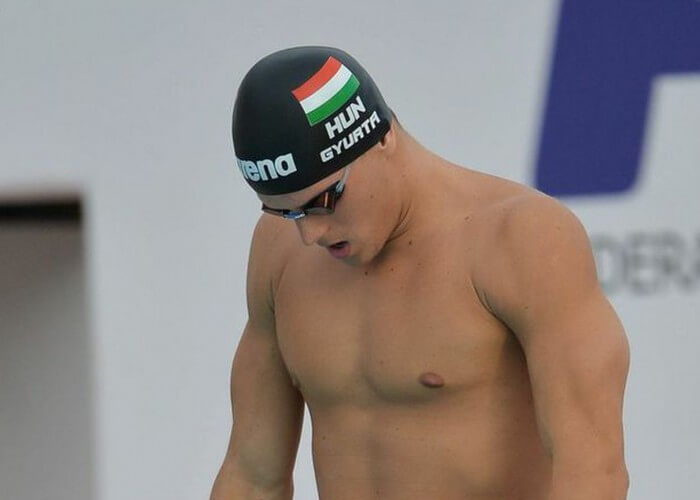
Daniel Gyurta – Photo Courtesy: Gian Mattia Dalberto/Lapresse
Milak spoke to Gyurta about that perilous pathway and how setbacks along the way should be “taken simply as a part of the learning process to longevity and knowing how to manage your energy”.
At World Juniors in 2017, a roasting summer schedule nearly completed, Milak faced his last test, the 200m butterfly. He was starting to feel the slog of the long haul but in the final, he surged and won the world junior crown by a relative ocean. Four golds and a bronze in the bag. He was upset that he hadn’t achieved what he’d aimed for.
That had nothing to do with the medals. He’s wanted to get inside the time in which Chad Le Clos claimed the world crown in Budapest when Milak was not in the race. The youngster had his eye not on the gulf to the rest of the juniors but on Le Clos and Cseh.
Asked in Gwangju if he could describe a typical day during a period of heavy training, he replied with a smile: “Then others would know what we do – and we don’t want to give our secrets away.”
With a reputation for steeliness building, Malik was once asked by his home media if he ought to be called “Iron Man” to Hosszu’s Iron Lady. He replied:
“What? Iron Man? No, absolutely not. I’m not looking for any kind of distinction. I will remain who I am: Kristóf Milák. I want to achieve something big as Kristóf Milák, period.”
At 13 years of age, Milak clocked 2:16.82 over 200 ‘fly at his first senior nationals championships. Two years on at nationals, the clock read 2:02.86 on the way to a massive leap at the European Junior Championships: 1:56.77. Then 1:53.79 in 2017 and a best 0.01sec shy of the 1:52.70 Cseh clocked in the Beijing 2008 final in which Phelps raced to gold in goggles sloshing with water.
At the time of missing Cseh’s mark, Milak expressed frustration that he felt he had more to give.
Gwangju has shown how right he was.
.jpg)

- 2017 WORLD CHAMPIONSHIPS
- OFFICIAL MEET PAGE
- WATCH RACE VIDEOS
- LIVE STREAM
- DAY 1 SWIMMING RESULTS
- DAY 2 SWIMMING RESULTS
- DAY 3 SWIMMING RESULTS
- DAY 4 SWIMMING RESULTS
- DAY 5 SWIMMING REULTS
- DAY 6 SWIMMING RESULTS
- DAY 7 SWIMMING RESULTS
- DAY 8 SWIMMING RESULTS
- RESULTS FOR ALL AQUATIC SPORTS
- DAY 8 PRELIMS HEAT SHEETS
- DAY 8 FINALS START LISTS
- FORM Swim for Coaches
- FORM Swim Sponsorships
- FORM Swim Contests
- FORM Swim Media




Excellent scholarly article.
Amazing article, what an info, and what a time and work. Hats off. Regards from the NL
As they should. That swim was insane.
Kristóf is amasing ❤️
Great article as always Craig….
Correction, check Phelps’ splits, you have him closing faster than Milak, 28.58 for a 1:50.51, rather than 29.58/1:51.51. Added a second.
Great article for a great swim !